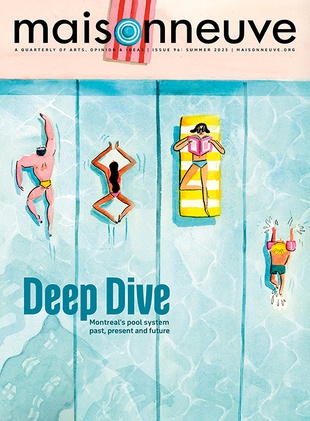The Imperial Purple
Guy Maddin's favourite symbolists
“Writers like Hemingway make me nervous. The things that make Hemingway so ‘Hem’ are all that stripped-down muscularity and the interior work of a different sort the reader has to do. I’m scared he’s going to make me whip out my penis and compare lengths. Maybe I can twist up a doily and shove that through my fly and scare him off.”—Filmmaker Guy Maddin
Antler-people roam a landscape of geometric tundra, grazing on hearts preserved in tears. Jagged shards of light appear at dizzying angles. Winnipeg beer baroness Lady Port-Huntley (Isabella Rossellini) presides over a Great Depression–era contest to determine the world’s bluest music.
These shadowy forms enshrouded in mist populate the universe of The Saddest Music in the World, the latest film by Canadian cult director Guy Maddin. Based on an original screenplay by Kazuo Ishiguro (Booker Prize–winning author of The Remains of the Day), the film conjures an atmosphere redolent of many artistic movements and eras, with a lush nod of the cravat to nineteenth-century symbolism. Maddin’s attraction to this tradition is evident throughout his oeuvre, which includes such films as The Imperial Purple, Tales From the Gimli Hospital, Fleshpots of Antiquity and Dracula: Pages from a Virgin’s Diary. His work is at once complex and dreamlike: images appear bathed in sacred awe, shot through a variety of archaic 8mm and 16mm lenses smeared with globs of Vaseline.
“I’ve had a wild, mad love affair with symbolism,” Maddin says. “All my passions for art movements are very unorganized. They are very wild and undisciplined and ignorant passions, kind of like love at first sight. They really are like crushes, or mad love obsessions, or even stalkings, because they’re irrational and they feel really fun to give yourself over to. You get into fights to defend the honour of these things that barely know that you exist. It always feels good to be just a little bit out of control.”
The original French and Belgian symbolists would have agreed with this sentiment. Overlapping with fin de siècle decadence, the symbolist movement was a revolution in art and poetry, primarily concerned with the attainment of other dimensions through visions, drugs, dreams, hallucinations and, most importantly, the use of symbols. A universe beyond the tangible reality of the here and now was their ultimate destination. Symbolists saw themselves as divers plundering exotic palaces of the mind, returning from the depths with poetic loot.
The movement is considered to have begun with the 1857 publication of Charles Baudelaire’s Les Fleurs du mal, but perhaps the most apt description of its aesthetic remains Arthur Rimbaud’s notion of an “intentional disordering of the senses.” Le Manifeste du Symbolisme, penned by Jean Moréas in 1886, proclaimed hostility toward “plain meanings, declamations, false sentimentality and matter-of-fact description.” Other major figures in the pantheon include poets Stéphane Mallarmé and Paul Verlaine, authors J. K. Huysmans and Rémy de Gourmont, and artists Odilon Redon and Gustave Moreau.
“I’m not even sure what a symbolist really is,” says Maddin. “I just like it when an author comes in and starts hanging up all sorts of mauve curtains and throwing doilies around the room.”
With that in mind, here are Maddin’s five purplest symbolists.
Joris Karl Huysmans (1848–1907)
J. K. Huysmans is best known for his intoxicating decadent masterwork, À Rebours (Against Nature), the “yellow book” that obsesses the protagonist of Oscar Wilde’s The Picture of Dorian Gray. Huysmans himself was fascinated with decay and his prose was flecked with vermilion bursts of corruption. “Bah, dust isn’t a bad thing,” he wrote in the satanic odyssey Là-Bas. “Besides having the taste of ancient biscuit and the smell of an old book, it is the floating velvet which softens hard surfaces, the fine dry wash which takes the garishness out of crude colour schemes . . . Who then can despise it?”
Maddin: I’ve modelled my apartment, and much of my own life, after the hero of Huysmans’s À Rebours. I have a jewel-encrusted tortoise, although the gems are merely semi- precious and the turtle’s been dead and stuffed for decades. And I have a houseboy (or housegirl, we’re not sure) come by for ninety minutes a day—all I can afford at the moment, but no self-respecting decadent can afford not to have an androgyne serving grapefruit at teatime. Huysmans wrote the guidebook for the mauve end of one century; I feel he can be reinterpreted to show us the Day-Glo way for the beginning of another.
Comte de Lautréamont (1846–1870)
Little is known about Isidore Lucien Ducasse. Born in Montevideo, Uruguay, the Frenchman later took the pseudonym Comte de Lautréamont and claimed to only write “at night seated at his piano.” André Breton wrote that Lautréamont’s book, Les Chants de Maldoror, is “the expression of a revelation so complete it seems to exceed human potential.” The entire surreal-ist international movement operated under the spell of his toenail-curling sentences: “handsome as the retract-ability of the claws of birds of prey” and “as beautiful as the chance meeting on a dissecting-table of a sewing-machine and an umbrella.”
Maddin: I don’t know if he’s considered a symbolist or just a sui generis whatnot. I think that his one book, Les Chants de Maldoror, is a pre-symbolist thing, but either way, he was adopted by all sorts of movements. At least the symbolists would work beneath his banner happily, knitted brows puzzling over his motives. I made a short film called Maldoror: Tygers inspired by him. He’s always a motivation to me.
Félicien Rops (1833–1898)
Félicien Joseph-Victor Rops was a Belgian artist and engraver who painted lascivious and morbid images: female satyrs blowing bubbles from phalluses, blindfolded women in silk stockings walking pigs, and skeletal angels. In a letter to Édouard Manet dated May 11, 1865, Baudelaire wrote, “Rops is the one true artist—what I and perhaps I alone mean by artist—that I have found in Belgium!” Rops himself said, “I am afraid of being old and of no longer being able to inspire love in a woman, which is a true death for a man of my nature and with my needs for madness of mind and body.”
Maddin: I’d like to make a movie about Félicien Rops. I like Odilon Redon so much that I made a picture about him (The Eye Like A Strange Balloon Mounts Toward Infinity). But I’m trying to figure out a way to do the Rops story without making it triple-X. He’s a Belgian painter and sketch artist, from around the same time as Redon, and he has these, what some people might say, very pornographic drawings, but they’re pretty beautiful and wild and ingenious.
Franz von Stuck (1863–1928)
Painter, sculptor, architect and engraver Franz von Stuck was a founder of the Munich Sezession. Paintings such as Sin, Salome, Lucifer and The Kiss of the Sphinx definitely place von Stuck in the greater pantheon of symbolism and decadence. In 1895 he became a professor at the Munich Academy, where his pupils included Klee, Albers and Kandinsky.
Maddin: Straddling the edge—kitschily—of symbolism, a late symbolist, sort of the Neil Diamond of symbolism, is Franz von Stuck. I kind of like him anyway. His paintings of “Sweet Caroline” and “Crackling Rose” are pretty good.
Gustave Moreau (1826–1898)
Hidden in Paris’ ninth arrondissement is the Musée Gustave Moreau. This museum, Moreau’s former abode and studio, opened its doors in 1903 and houses over six thousand of the artist’s oil paintings, drawings and watercolours. J. K. Huysmans was a fevered admirer of Moreau’s, prone to enthusiastic pronouncements like “Abandoned to ecstasy, he sees the enchanted visions and bleeding apotheoses of other ages.” Guy Maddin also marvels at Moreau: the director’s Twilight of the Ice Nymphs is a messianic homage to the French master.
Maddin: He’s my favourite, actually. I wish he wrote tons of short stories too. I wish I could figure out a way of entering him through the word, or the pointed camera somehow, but I think he’s canvas-specific. I go to the Moreau house almost every time I go to Paris. One of these times, I’m hoping the guards will take down the cordons and let me stretch out in his den and let me take that bell jar off all those stuffed colourful birds and they’ll suddenly all fly away.





